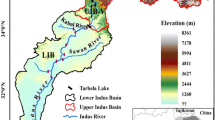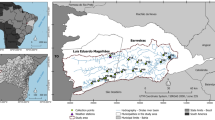Abstract
The study was carried out by using multivariate statistical methods, geochemical modeling (GIS maps), WQI and conventional designs to categorize the hydrochemical feature of the region. The drainage water is being dumped into the Rice Canal which is making canal water polluted, and people are consuming the Rice Canal water for drinking purposes; therefore, it is a concern for human health. A total of 18 water samples were composed: 9 from the Rice Canal and 9 from the Larkana drainage water. The sampling was repeated 3 times in a year and investigated for physicochemical and heavy metals. The GIS maps of cations and anions indicated that sewage drained in the Rice Canal showed a high risk to human health and made the Rice Canal water unfit for drinking. The higher level of chemical oxygen demand (COD), particularly during the post-monsoon season was of concern because of low freshwater discharge. The water quality index (WQI) of the Rice Canal water indicated that all samples were found in excellent to good for drinking, and 100% were present in excellent to good for cultivation. The WQI of drainage water indicated that 100% were good for irrigation. The contamination index (Cd) of drainage water of the majority of the samples exhibited a high threat to humans. The HQ value of drainage water of one sample showed a higher level of cadmium. Arsenic in 2 samples crossed the allowable limit and exposed high risk for the human body. The CDI value of drainage water showed risk in some samples, but the Rice Canal water did not show risk for human health, because of dilution by fresh water. The Gibbs diagram showed that the Rice Canal water was found in the rock-dominance category, and drainage water samples were in evaporation dominance. The Piper diagram showed that the majority of samples were present in the mixed-type water category.














Similar content being viewed by others
Data availability
The authors do not have an association with organizations and no data availability statement.
References
Amjad H, Hamid S, Niaz Y, Ashraf M, Yasir U, Amna C, Daud MW (2019) Efficiency assessment of wastewater treatment plant: a case study of Pattoki, District Kasur, Pakistan. Earth Sci Pak 3:1–4
APHA (2005) Standard methods for the examination of water and waste water, 21st edn. American Public Health Association, Washington
Bahita TA, Swain S, Pandey P, Pandey A (2021) Assessment of heavy metal contamination in livestock drinking water of Upper Ganga Canal (Roorkee City, India). Arab J Geosci 14(24):1–13
Daud MK, Nafees M, Ali S, Rizwan M, Bajwa RA, Shakoor MB, Zhu SJ (2017) Drinking water quality status and contamination in pakistan. BioMed Res Intern 2017:7908183. https://doi.org/10.1155/2017/7908183
Dewani VK, Ansari IA, Khuhawar MY (2003) Profile of metal contents of sewage contaminated canal fishes. J-Chem Soc Pak 25(1):37–40
Deweani V, Khuhawar M, Ansari I (2011) Sediment analysis of sewage contaminated canal. J Chem Soc Pak 27(6):154
Elhaddad E, Al-Zyoud S (2017) The quality assessment of pollution of Rosetta branch, Nile River, Egypt. Arab J Geosci 10(5):1–11
Ijaz MW, Mahar RB, Solangi GS, Panhwar S, Ansari AK (2017) Impairment of water quality of Phuleli Canal, Sindh Pakistan: a review. Mehran Univ Res J Eng Technol 36(3):681–692
Ketata-Rokbani M, Gueddari M, Bouhlila R (2011) Use of geographical information system and water quality index to assess groundwater quality in El Khairat Deep Aquifer (Enfidha, Tunisian Sahel), Iranica. J Energy Environ 2(2):133–144
Khan S, Cao Q, Zheng YM, Huang YZ, Zhu YG (2008) Health risks of heavy metals in contaminated soils and food crops irrigated with wastewater in Beijing, China. Environ Pollut 152(3):686–692
Khuhawar MY, Lanjwani MF, Jahangir Khuhawar TM (2021) Assessment of variation in water quality at right bank outfall drain, including manchar lake, sindh, pakistan. Intern J Environ Anal Chem 1–23
Lanjwani MF, Khuhawar MY, Jahangir Khuhawar TM, Lanjwani AH, Jagirani MS, Kori AH, Muhammad Dodo J (2020a) Risk assessment of heavy metals and salts for human and irrigation consumption of groundwater in Qambar city: a case study. Geol, Ecol, Landsc 4(1):23–39
Lanjwani MF, Khuhawar MY, Khuhawar TMJ (2020b) Groundwater quality assessment of Shahdadkot, Qubo Saeed Khan and Sijawal Junejo Talukas of District Qambar Shahdadkot, Sindh. Appl Water Sci 10(1):1–18
Lanjwani MF, Khuhawar MY, Khuhawar TMJ, Samtio MS, Memon SQ (2021) Spatial variability and hydrogeochemical characterisation of groundwaters in Larkana of Sindh, Pakistan. Groundw Sustain Dev 14:100632
Lanjwani MF, Khuhawar MY, Jahangir Khuhawar TM (2022a) Assessment of groundwater quality for drinking and irrigation uses in taluka ratodero, district larkana, sindh, pakistan. Intern J Environ Anal Chem 102(16):4134–4157
Lanjwani MF, Khuhawar MY, Khuhawar TMJ, Memon SQ, Samtio MS, Lanjwani AH, Rind IK (2022b) Spatial distribution of hydrochemistry and characterization of groundwater of Taluka Bakrani, Larkana, Sindh, Pakistan. Arab J Geosci 15(5):1–24
Lanjwani MF, Khuhawar MY, Jahangir Khuhawar TM, Lanjwani AH, Soomro WA (2023) Evaluation of hydrochemistry of the Dokri groundwater, including historical site Mohenjo-Daro, Sindh, Pakistan. Intern J Environ Anal Chem 103(8):1892–1916
Mahessar AA, Qureshi S, Qureshi AL, Ansari K, Dars GH (2020) Impact of the effluents of Hyderabad City, Tando Muhammad Khan, and Matli on Phuleli Canal water. Eng, Technol Appl Sci Res 10(1):5281–5287
Mir RA, Gani KM (2019) Water quality evaluation of the upper stretch of the river Jhelum using multivariate statistical techniques. Arab J Geosci 12(14):1–19
Mohan D, Shukla SP (2022) Hazardous consequences of textile mill effluents on soil and their remediation approaches. Clean Eng Technol 5:100434
Muhammad S, Shah MT, Khan S (2010) Arsenic health risk assessment in drinking water and source apportionment using multivariate statistical techniques in Kohistan region, northern Pakistan. Food Chem Toxicol 48(10):2855–2864
Natasha, Shahid M, Khalid S, Murtaza B, Anwar H, Shah AH, Sardar A, Shabbir Z, Niazi NK (2020) A critical analysis of wastewater use in agriculture and associated health risks in pakistan. Environ Geochem Health 1–20
Panhwar MY, Panhwar S, Keerio HA, Khokhar NH, Shah SA, Pathan N (2022) Water quality analysis of old and new Phuleli Canal for irrigation purpose in the vicinity of Hyderabad, Pakistan. Water Pract Technol 17(2):529–536
Qureshi S, Mastoi GM, Ghanghro AB, Mastoi AW (2012) Impact of sewage water on quality of Fullali Canal Water, Hyderabad, Sindh, Pakistan. Springer Vienna, pp 191-197
Rajasulochana P, Preethy V (2016) Comparison on efficiency of various techniques in treatment of waste and sewage water–a comprehensive review. Resour-Eff Technol 2(4):175–184
Sardar K, Ali S, Hameed S, Afzal S, Fatima S, Shakoor MB, Tauqeer HM (2013) Heavy metals contamination and what are the impacts on living organisms. Greener J Environ Manag Public Saf 2(4):172–179
Sarkar B, Islam A (2019) Assessing the suitability of water for irrigation using major physical parameters and ion chemistry: a study of the Churni River, India. Arab J Geosci 12(20):1–16
Seleem EM, Mostafa A, Mokhta M, Salman SA (2021) Risk assessment of heavy metals in drinking water on the human health, Assiut City, and its environs, Egypt. Arab J Geosci 14(6):1–11
Soomro A, Siyal AA, Mirjat MS, Sial NB (2013) Seasonal variability of trace and heavy metals concentration in groundwater and its quality for drinking and irrigation purpose under Phuleli Canal command area (Sindh), Pakistan. J Basic Appl Sci 9:550
Soomro A, Siyal AA, Mirjat MS, Sial NB (2014) Seasonal variations of trace elements and heavy metal concentrations in Phuleli Canal water (Sindh), Pakistan. Sarhad J Agric 30:73–82
Tariq M, Anayat A, Waseem, M, Rasool MH, Zahoor MA, Ali S et al (2020) Physicochemical and bacteriological characterization of industrial wastewater being discharged to surface water bodies: significant threat to environmental pollution and human health. J Chem 2020:1–10
Tripathi M, Singal SK (2019) Allocation of weights using factor analysis for development of a novel water quality index. Ecotoxicol Environ Saf 183:109510
USEPA M (2005) Guidelines for carcinogen risk assessment. In risk assessment forum US environmental protection agency, washington, DC EPA/630/P-03 F (Vol. 1)
Vörösmarty CJ, McIntyre PB, Gessner MO, Dudgeon D, Prusevich A, Green P et al (2010) Global threats to human water security and river biodiversity. Nature 467(7315):555–561
Wang S (2008) A comparative study of Fenton and Fenton-like reaction kinetics in decolourisation of wastewater. Dyes Pigm 76(3):714–720
Author information
Authors and Affiliations
Corresponding author
Ethics declarations
Conflict of interest
The authors declare no competing interests.
Additional information
Responsible Editor: Broder J. Merkel
Supplementary Information
Below is the link to the electronic supplementary material.
Rights and permissions
Springer Nature or its licensor (e.g. a society or other partner) holds exclusive rights to this article under a publishing agreement with the author(s) or other rightsholder(s); author self-archiving of the accepted manuscript version of this article is solely governed by the terms of such publishing agreement and applicable law.
About this article
Cite this article
Lanjwani, M.F., Khuhawar, M.Y., Tuzen, M. et al. GIS-based spatial variability of COD and heavy metals owing to Larkana City sewage drained into the Rice Canal, Sindh, Pakistan. Arab J Geosci 16, 416 (2023). https://doi.org/10.1007/s12517-023-11502-1
Received:
Accepted:
Published:
DOI: https://doi.org/10.1007/s12517-023-11502-1




